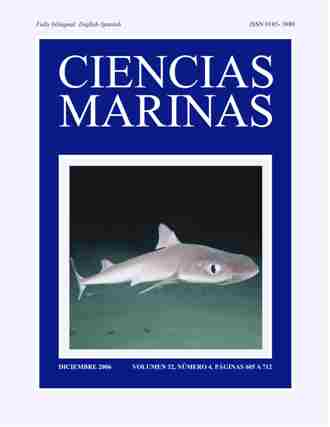Fish community of a fringing reef at Mochima National Park, Venezuela
Main Article Content
Abstract
Se analizó la comunidad de peces asociada a una franja arrecifal en Cautaro, Parque Nacional Mochima, Venezuela. Las observaciones y conteo de las especies se realizaron mensualmente, desde diciembre de 2000 hasta mayo de 2002, mediante censos visuales y a una profundidad media de 2 m. Se identificaron 86 especies, pertenecientes a 31 familias. Las familias con mayor número de especies fueron Scaridae (10), Haemulidae y Labridae (9), así como Pomacentridae (7) y Serranidae (6), las cuales, conjuntamente con la única especie de Sparidae, acumularon 77.52% de la abundancia total. Las especies Diplodus argenteus (13.15%), Microspathodon chrysurus (13.00%) y Thalassoma bifasciatum (10.79%) fueron las más abundantes y frecuentes (>50%), por lo que pueden considerarse típicas y características del área estudiada. La diversidad total fue de 4.54 bits ind–1 y osciló entre 3.33 y 4.25 bits ind–1 con un promedio de 3.86 bits ind–1. La equitabilidad varió entre 0.74 y 0.89. El número de individuos por especie, en relación al rango, se ajustó con una regresión lineal altamente significativa (r = 0.976) y un índice de diversidad de la serie logarítmica de = 14.19. El análisis trófico de la comunidad indicó que las especies carnívoras constituyeron el grupo dominante (63.10%), seguido por las herbívoras (21.40%) y omnívoras (15.50%). No se detectaron diferencias significativas entre el número de especies observadas y el esperado de acuerdo con la distribución Log-normal, lo cual indica una tendencia a la estabilización en relación al número de especies.
The fish community associated with a fringing reef was studied at Cautaro, Mochima National Park, Venezuela. A systematic sampling design based on visual censuses was carried out from December 2000 to May 2002. A total of 86 species belonging to 31 families were identified, dominated by Scaridae (10), Haemulidae and Labridae (9), Pomacentridae (7) and Serranidae (6), which accumulated, together with the sole species of Sparidae, 77.52% of the total abundance. Diplodus argenteus (13.15%), Microspathodon chrysurus (13.00%) and Thalassoma bifasciatum (10.79%) were the most abundant and frequent (>50%) species, and can therefore be considered typical and characteristic of the study area. The total diversity was 4.54 bits ind–1 and oscillated between 3.33 and 4.25 bits ind–1, with an average of 3.86. Equitability varied between 0.74 and 0.89. The relationship between species abundance and rank was significant (r = 0.976) and the diversity index of the log-series based on the number of species was = 14.19. The trophic analysis of the community indicated that the carnivorous species constituted the dominant group (63.10%), followed by the herbivores (21.40%) and omnivores (15.50%). The normal distribution fitted the species abundance data, indicating a tendency towards stabilization in relation to the number of species.
The fish community associated with a fringing reef was studied at Cautaro, Mochima National Park, Venezuela. A systematic sampling design based on visual censuses was carried out from December 2000 to May 2002. A total of 86 species belonging to 31 families were identified, dominated by Scaridae (10), Haemulidae and Labridae (9), Pomacentridae (7) and Serranidae (6), which accumulated, together with the sole species of Sparidae, 77.52% of the total abundance. Diplodus argenteus (13.15%), Microspathodon chrysurus (13.00%) and Thalassoma bifasciatum (10.79%) were the most abundant and frequent (>50%) species, and can therefore be considered typical and characteristic of the study area. The total diversity was 4.54 bits ind–1 and oscillated between 3.33 and 4.25 bits ind–1, with an average of 3.86. Equitability varied between 0.74 and 0.89. The relationship between species abundance and rank was significant (r = 0.976) and the diversity index of the log-series based on the number of species was = 14.19. The trophic analysis of the community indicated that the carnivorous species constituted the dominant group (63.10%), followed by the herbivores (21.40%) and omnivores (15.50%). The normal distribution fitted the species abundance data, indicating a tendency towards stabilization in relation to the number of species.
Downloads
Download data is not yet available.
Article Details
How to Cite
Méndez de E, E., Ruiz, L., Prieto, A., Torres de J, A., Fariña, A., Sant, S., … Marin, B. (2006). Fish community of a fringing reef at Mochima National Park, Venezuela. Ciencias Marinas, 32(4), 683–693. https://doi.org/10.7773/cm.v32i4.1159
Issue
Section
Research note
This is an open access article distributed under a Creative Commons Attribution 4.0 License, which allows you to share and adapt the work, as long as you give appropriate credit to the original author(s) and the source, provide a link to the Creative Commons license, and indicate if changes were made. Figures, tables and other elements in the article are included in the article’s CC BY 4.0 license, unless otherwise indicated. The journal title is protected by copyrights and not subject to this license. Full license deed can be viewed here.

